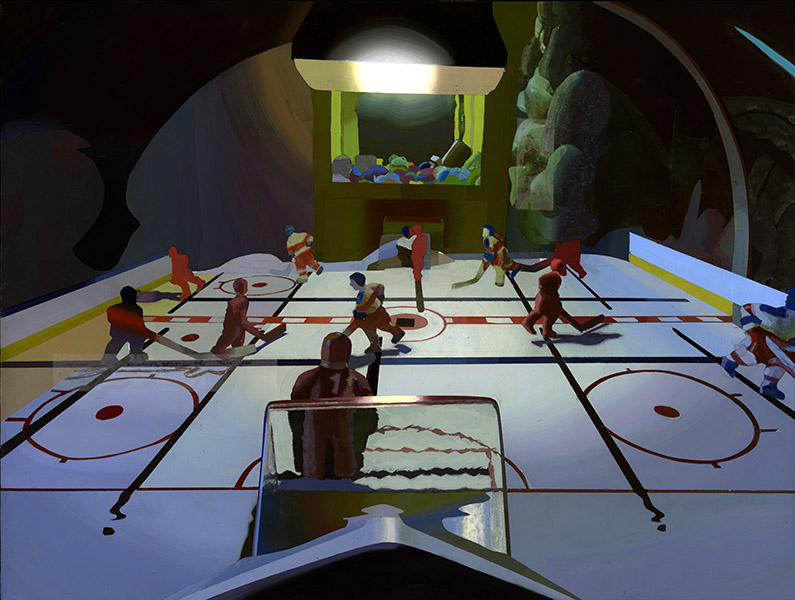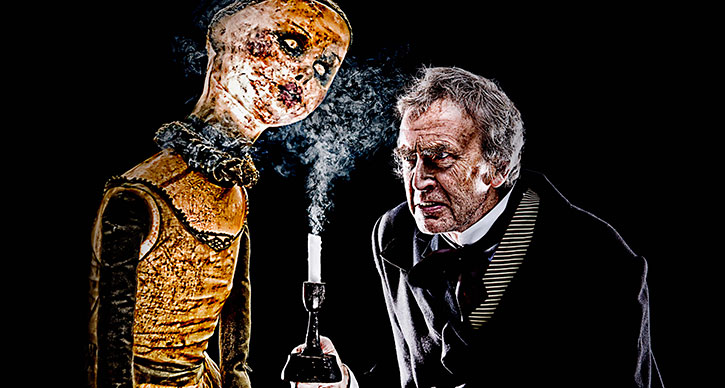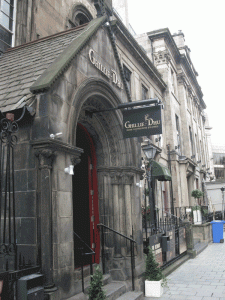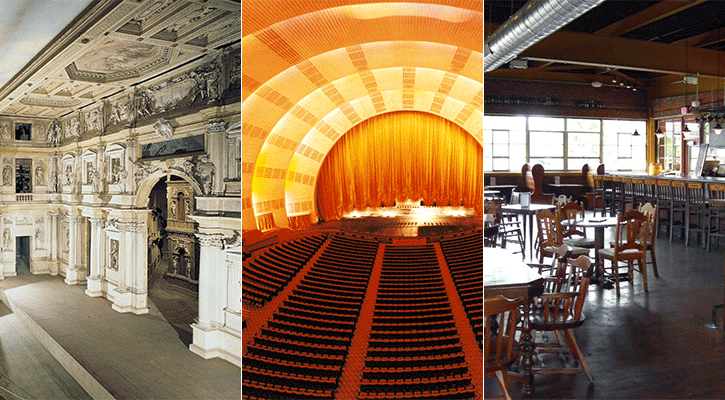UMS Artist in Residence Update: New Paintings by Siobhan McBride
Editor’s note: Siobhan McBride is a visual artist and one of our 2015-2016 artists in residence. As part of this program, artists in residence attend UMS performances to inspire new thinking and creative work within their own art forms. Siobhan attended A Christmas Carol, by the National Theatre of Scotland. Below is her response to the performance.
Here are a couple of paintings I’ve been working on recently:


Photos: New painting by Siobhan McBride.
I’ve always felt more comfortable in enclosed spaces. I prefer my back to the wall in restaurants, booths rather than tables, sleeping bags, attic spaces, small groves of trees, the geometry of a clam shell. A trapped elevator scenario causes me no grief.
In a large studio I once occupied, I built a cave out of paper mache and chicken wire, simply furnished with a busted short-legged upholstered chair. I used it as a panic room. A place to curl up, read, obsessively playback unfortunate social interactions, or nap. A space that denied attackers the advantage of surprise. Likewise, the spaces in my paintings tend to feel compressed, close. I like flatness, painted elements pressed forward, tectonically still, or shallowly shuffling like playing cards.
The hockey painting is unfinished. It has a distinctly differently space than many of my other paintings, perhaps influenced by recently seeing a number of performances on stages at Hill Auditorium and the Power Center as part of the UMS residency. The sense of enclosure is present in the painting, but more vaguely so.
I’ve always been fond of creating scenes from a seemingly hidden vantage point, like a hunting blind, a battlement, seeing without the burden of being seen. A different kind of enclosure, that is apart from the scene rather than within it.

Photo: Scene from A Christmas Carol. Photo courtesy of the artists.
In December, I saw A Christmas Carol performed by the National Theatre of Scotland. The set was small and tight (my ideal viewing situation!) and the presence of haze allowed me to literally disappear in a puff of smoke while I enjoyed some amazing, often alarming puppets and the details of their incredible set.
Interested in more? Follow the adventures and process of other UMS Artists in Residence.
Director’s Note: A Christmas Carol
National Theatre Scotland’s A Christmas Carol is at Power Center, within a special set on stage, December 17-January 3, 2016. Only 150 audience members per show join Ebenezer Scrooge in his Victorian counting house and sit in creepy close-up as this most famous of misers is visited by three ghosts during his night of soul-searching.
Below, director Graham McLaren shares his take on Charles Dickens’s classic fable.

Photo: Moment in A Christmas Carol. Photo by Mark Hamilton.
It is said that Charles Dickens, along with Prince Albert who introduced the Christmas tree and the Christmas card to Britain, helped to create our idea of Christmas about 150 years ago. If he did, it’s more likely that was a by-product from the success of his story, not its primary aim. Yes, it is set at Christmas time and takes the form of a fable or carol, but its contents deal with social injustice and result in a cry for change and direct action.
On behalf of the poor man’s child
While it may be true that Dickens wrote his story in 1843, the same year in which the first ever Christmas card was created and sent, more significant is that it was also the year of the publication of a report by the Children’s Employment Commission. This report was a detailed and damning account of the appalling working conditions that children suffered at the time, and so inflamed him that he started to write a pamphlet called An Appeal to the People of England, on Behalf of the Poor Man’s Child. He abandoned it when he realized he needed a more popular form to reach the masses. So he wrote the story of an old man with a heart as cold as winter itself. He has such a terrible night alone with his conscience that he learns to treat his fellow men and women with kindness, generosity and compassion, gaining a reputation as a man who embodies the very spirit of Christmas.
It is, however, the way Dickens writes his vision of the world that leaves its inky scratches on our memory. Even the very best of Dickens illustrators such as Cruikshank and Phiz can’t begin to capture the grotesque characters that haunt his work.
Politics and atmosphere
The challenge for us, in creating this production for you, has been: how do we best serve Dickens’ social and political agenda, and at the same time create the extraordinary atmosphere that his story demands? It is this question that guided us through the process of creating this show, and led us, for instance, to the use of puppetry for the ghosts and visions, and our desire to bring you close to the action by surrounding you with the set.
In developing our version of this enduring tale, we concentrated on what I believe to be the very heart of the story, where Scrooge asks The Ghost of Christmas Present: “What is that protruding from your skirts—is it a foot or a claw?” The Ghost responds with a warning that these children are “Ignorance” and “Want” and to “Beware them both, but most of all beware the boy for on his brow I see that written which is Doom.”
We wanted to challenge all notions of sentimental stage and screen adaptations of A Christmas Carol, and so kept returning to Dickens’ writings in an effort to be true to his appeal “on behalf of the poor man’s child.” We hope you enjoy it.
Your presence is requested at the offices of Messrs. Scrooge and Marley December 17-January 3.
The Power (or Not) of Place
Editor’s note: The National Theatre of Scotland performs A Christmas Carol on December 17 – January 3, 2016. The performance take place in an unconventional space: inside a box on the stage of the theater.
In my early twenties, I joined a children’s theater company and for half a year toured southeastern Pennsylvania putting on plays in elementary schools. I’d done my share of theater elsewhere, but nothing approached the energy of those performances. Every day we’d troupe off to another school to give our show and do a workshop. I’d been told children were the most demanding of audiences, but I never felt less than welcome anywhere we went, maybe because most kids were giddy with pleasure at the arrival of a bunch of costumed adults in their midst. (I played a dog.) It’s one thing to go to the theater, another to have it erupt in your cafeteria on a rainy weekday morning, much the way medieval pageants used to erupt in town squares.
We had little scenery and one change of clothes. I suspect we weren’t far from the kind of enterprise Peter Brook had in mind when he said the only thing needed for an act of theater to take place is for one person to walk across an empty space while someone else watches. The kids who sat cross-legged on carpet squares watching us perform certainly didn’t seem to distinguish between what we were doing and what took place downtown in the fancy 19th-century opera house our troupe called home—the kind of building Brook had in mind when he said of the theater: “Red curtains, spotlights, blank verse, laughter, darkness, these are all confusedly superimposed in a messy image covered by one all-purpose word.”
Photo (L to R): Palladio’s Olimpico, Radio City Music Hall, the Corner Brewery.
God knows the human thirst for stories has led to some amazing spaces: the ancient Greek amphitheaters with their literal sky, Palladio’s ornate Olimpico with its figurative one, Shakespeare’s Globe, the Sydney Opera House, Radio City Music Hall. But as pieces like Prudencia Hart remind us, it doesn’t much matter where plays are performed—or maybe it does matter, just not in ways we’ve been taught to expect. “Space that has been seized upon by the imagination,” writes Gaston Bachelard, “cannot remain indifferent space subject to the measures and estimates of the surveyor.” Performance transforms the sites we inhabit. I’ve often wondered if those elementary-school kids thought differently about their surroundings after we’d left. I hope so. Surely Ypsi’s Corner Brewery will be changed, perhaps in lasting ways, by what takes place inside it this January 8-13.
In a 2010 TED talk, Ben Cameron of the Doris Duke Foundation suggested that many purpose-built arts venues “were designed to ossify the ideal relationship between the artist and audience most appropriate to the 19th century.” Cameron and others argue that unless performing arts organizations rupture traditional thinking about arts settings, the whole culture of performance will stagnate.
It strikes me that what’s happening in the performing arts—where conventional performance venues are increasingly yielding to breweries, planetariums, armories, rivers (our own Huron!), and the local multiplex (witness the global appeal of the Met’s live broadcasts)—is not unlike what’s happening in the world of print publishing. Where either will end up is anyone’s guess, but we’re clearly changing the way we communicate—and with whom. When the Boston Lyric Opera presented two free outdoor performances of Carmen in 2002, more than 100,000 people showed up. A third of them were seeing an opera for the first time.
The National Theatre of Scotland proudly states on its website that it has “no building,” and therefore has “no bricks-and-mortar institutionalism to counter, nor the security of a permanent home in which to develop. All our money and energy can be spent on creating the work”—which they perform in places as varied as car parks, forests, Edinburgh’s Royal Lyceum, and Ypsi’s Corner Brewery.
Back when I toured with the kids’ theater troupe, we had no box office, no lobby, no lights, no stagehands, no drops descending from on high, no tickets or sound system or props— just ourselves and what we could carry in the back of a station wagon. Our audiences didn’t care. Maybe some of it had to do with their age. But I’m sure it also had to do with the enduring power of make-believe, the freedom that actors represent, and the startling discoveries that can happen when a familiar space is made new, and the audience with it.
Delinquent Dispatch from Fringe
Image: The Simple Things in Life
 My sincerest apologies…I’m a little delinquent here with my second “dispatch.” I was operating at a fairly severe sleep deficit for a bit there. But I’m back and ready to share some last highlights from a whirlwind trip to my favorite European city (a title I’ve also been known to bestow on Budapest when I want to sound a little more exotic).
My sincerest apologies…I’m a little delinquent here with my second “dispatch.” I was operating at a fairly severe sleep deficit for a bit there. But I’m back and ready to share some last highlights from a whirlwind trip to my favorite European city (a title I’ve also been known to bestow on Budapest when I want to sound a little more exotic).
Best Thing Ever
On Tuesday, I saw the best thing ever. I’ll be the first to admit that I tend to speak in hyperbole at times. And I’ve generally tried to temper my enthusiasm (or lack thereof) for the purposes of work-related blog posts. So, with that initial caveat, I hereby reaffirm my initial statement and proclaim 1927’s “The Animals and Children Took to the Streets” as The Best Thing Ever. 1927 is a UK-based company that mixes live music, performance, and animation. Inspired by silent film, this piece has a “live” cast of three actors interacting with animated ones, including a posse of really, really poorly-behaved children, a horde of cockroaches, and cat named Mr. Meow, all residents of a decrepit tenement block known as “the Bayou.” It’s very rare that I’m able to fully disengage with the world around me and lose myself in an experience, but this performance was so cleverly and expertly choreographed that I actually felt a little like I was trapped in a cartoon. Rest assured that I’ll be badgering a certain Director of Programming ‘round these parts to consider this one for possible inclusion in a future season.
That National Theatre
On my last day in Edinburgh, I managed to squeeze in one more show and “experience” before rushing (understatement) to the airport. (I admit—I harbored a secret hope of not making my flight and being granted an extra night in the city.)
I made my way to the Traverse Theatre to see another National Theatre production. Not the National Theatre (of London, whose delayed broadcast screenings UMS presents throughout the season in partnership with the Michigan Theater), nor the National Theatre of Scotland (whose “Strange Undoing of Prudencia Heart” I espoused in my last post). This time, it was the National Theatre Wales and their production of “The Dark Philosophers,” an adaptation of the life and stories of Welsh writer Gwyn Thomas. Gwyn wrote some dark stuff, most of it tinged with a humorous edge. The setting for this piece is a Welsh mining community, the mountain referenced throughout represented by a plot of wardrobes, dressers, and the like. The tone of the play reminded me a bit of Martin McDonagh’s “Cripple of Inishmaan” performed here last season by the Druid Theatre Company. Previously unfamiliar with Gwyn Thomas (as I was with Martin McDonagh), I wasn’t sure if was I allowed to laugh. I wanted to. The knowing audience around me eventually did. And, similar to “Cripple,” I was left with a sense of the insular nature of a community mostly isolated from those surrounding it—the character and cadence of the local life different from anywhere else.
The Simple Things in Life
The last thing I went to was “The Simple Things in Life.” Housed in the Royal Botanic Garden, five artists were tasked with creating an experience celebrating the simple things in life, each to be housed within a small shed. The goal: to create “a haven within the hubbub of the festival.” First stop: “Lost in Words.” This shed, created by Lewis Gibson, was an exercise is looking (through viewfinders), listening (to calming soundscapes), and reading (a weaving of text excerpts from famous stories…Moby Dick, The Tell-Tale Heart, The Nightingale and the Thorn). It was a nice reprieve from the inner voice inside my head, a constant companion that at the time was worrying/hoping I was going to miss my upcoming/looming flight.
Snorkelling Team
The journey ended at the London Snorkeling Team’s shed, the location of The 2011 Annual Science Demonstration and Space Fête. The London Snorkelling Team are funny fellows. Funny fellows that play music and draw cartoons that are projected and “animated” on a standard-issue classroom overhead projector. You know, the kind used in the olden days. Audience members were given a glimpse into the workings of an interesting new take on a particle accelerator. Not one tasked with answering the greatest mysteries in the Universe, no. In this instance, the particles to be collided included a pig and a cow, the intended result being a shower of meat. Ludicrous and fun. Just like the animated fight between Carl Sagan and Stephen Hawking. As good a place as any to end things.
Dispatch from Fringe
 Oh goodness me! I’m back in Edinburgh! During the Fringe! The largest arts festival in the world! It’s been 9 years exactly since my last (and first) visit, when I came as part of the American High School Theatre Festival. A recent high school graduate at the time, I was tasked with running the light board for a musical version of the Ugly Duckling called Honk! Yikes! (This is reminding me that my 10 year high school reunion is nigh. Double yikes!!)
Oh goodness me! I’m back in Edinburgh! During the Fringe! The largest arts festival in the world! It’s been 9 years exactly since my last (and first) visit, when I came as part of the American High School Theatre Festival. A recent high school graduate at the time, I was tasked with running the light board for a musical version of the Ugly Duckling called Honk! Yikes! (This is reminding me that my 10 year high school reunion is nigh. Double yikes!!)
I arrived only yesterday, but I feel like I’ve been here for ages. That’s what happens when something literally takes over a city. If you’ve never been, the Fringe is to Edinburgh as a football game at the Big House is to Ann Arbor. But sustained for a month! The energy is at an all-time high from morning ‘til, well, it never stops!
I’ve seen exactly 8 shows as of now, 11:37pm local time, Monday, August the 22nd. 6 of them today. Yes. 6. And some of them more “experience” than “show.” Here’s a little taste.
The first show I saw was the National Theatre of Scotland’s The Strange Undoing of Prudencia Hart at the Ghillie Dhu, a local pub. Written by playwright David Grieg, the story follows an uptight academic named Prudencia as she travels out of town for a conference, and learns to loosen up along the way. How this happens is the crux of the action, the fun, and the heartache, some of which can be seen in this youtube video. The National Theatre of Scotland has had some hits on their hands as of late—most recently in the U.S. with their production of Black Watch. If the buzz surrounding this one at the Fringe is any indication, you just might see this one at a pub near you. I sure hope so.
Today’s marathon of shows included the premiere of a work in progress called A Reply to Kathy Acker: Minsk 2011 by incendiary political theater-makers, Belarus Free Theatre. BFT was founded in 2005 by a husband and wife team in response to the pressure and censorship of Europe’s last surviving dictatorship. Under constant threat of persecution, the group’s rehearsals and performances are often held in secret , and have at times been broken up by police. In their short history, members of the company have faced harassment, beatings, and even arrest. In this piece, the audience was given a glimpse into Minsk today from the artists’ perspective. And it was, in a word, brutal. They’re a brave group. And their acting is likewise brave. It’ll be interesting to see how the work develops.
Later in the evening, I was able to catch David Leddy’s newest work called The Untitled Love Story. Some of you may remember David’s Susurrus made an appearance in Ann Arbor this past year out at Matthaei Botanical Gardens. Though this piece was housed in a more traditional theatrical setting, the hallmarks of David’s style of writing rang loud and clear. His knack for weaving seemingly disparate storylines into one cohesive production is astounding and the story all the more powerful because of it. And, as with Susurrus, the use of music is crucial—and used to great effect. Here are the basics: the setting is Venice. The characters are known only as the Collector, the Historian, the Priest, and the Writer—two men and two women who have all suffered/will come to suffer great loss. It’s not all sad though! I promise!
The night ended with a short 15 minute “live video” experience for one called And the Birds Fell From the Sky by Brighton-based Il Pixel Rosso. In a nutshell, I joined a group of nomadic criminal clowns (collectively known as the Faruk) for a car ride. Crimes were committed. Birds fell from the sky. I was supremely freaked out. And I totally loved it. Logistically, it involved an impressive pair of video goggles synced up with an in-ear audio track. An actor unseen to the audience member provided the other tactile sensations—smells, touch, movement . All in all, a deep and bizarre Fringe experience. The best kind.
* * *
Have you been to the Fringe? Are you at the Fringe now? Share your experiences below.



